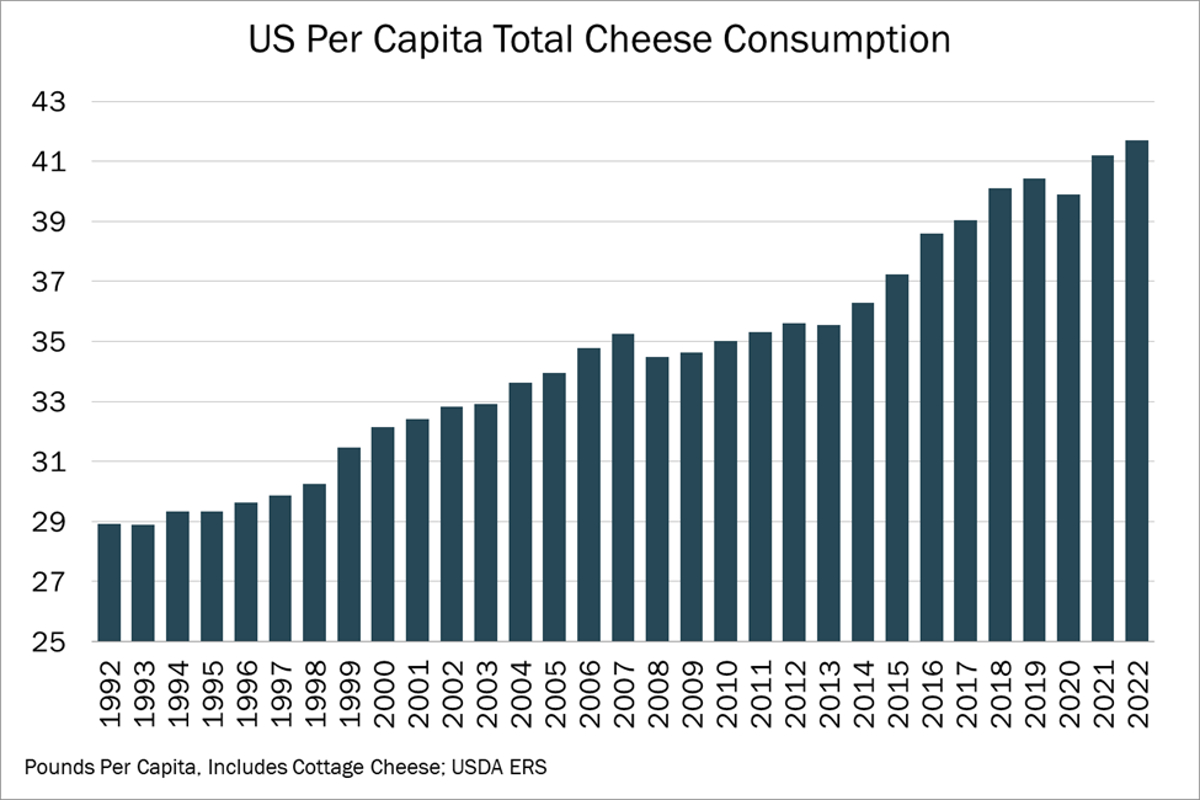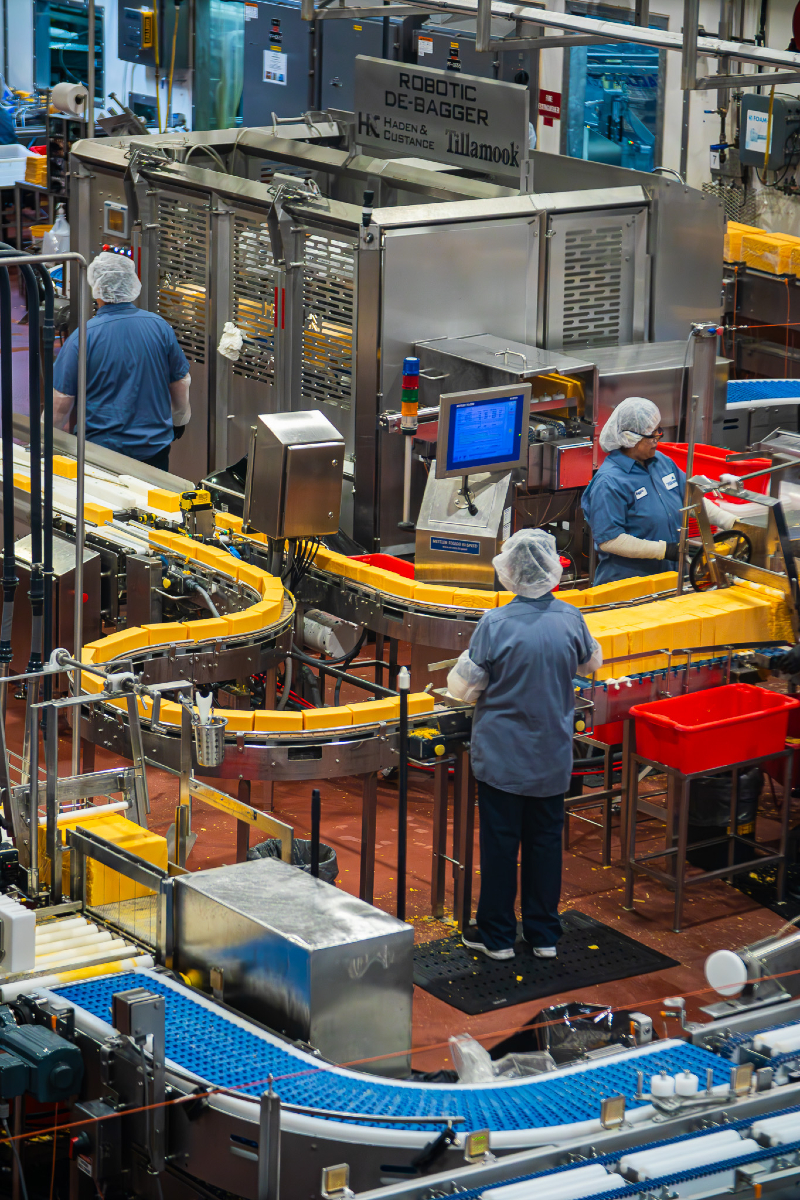As the demand for cheese consumption and production increases, between rising demand from within the food industry and developing food trends, the cheese segment is driving the dairy market.
The size of the world cheese market is estimated to increase by $39.1 billion by 2027, according to Technavio. The market’s growth momentum will progress at a CAGR of 4.5% during the forecast period, with growth being driven by an increase in cheese consumption globally, as well as more availability in different forms.
“Dairy’s not declining; dairy is growing. We’re simply eating more of our dairy than we’re drinking,” Michael Dykes, president and chief executive officer, IDFA, told attendees at the IDFA Dairy Forum in January. “Cheese is driving the bus … and cheese is paving the way for other products to come along, as well.”
Rampant growth
According to data from the US Department of Agriculture (USDA), per capita consumption of all dairy products reached 653 lbs per person in 2022 – 63 lbs above the historical average dating back to 1975, when USDA began tracking per capita dairy consumption. Cheese consumption set an all-time high in 2022 to reach nearly 42 lbs per person, a half-a-pound per-person increase over the previous year.
For comparison, the average American consumed 32.2 lbs of cheese in 2000 and 21.9 lbs in 1980. This increase is impacting the market across the board.
Due to higher demand for cheese production, Class IV milk is expected to maintain a premium throughout 2024, according to Lucas Fuess, senior dairy analyst at Rabobank, who shared his insights while speaking to attendees in February at the International Sweetener Colloquium, which is co-sponsored by IDFA and the Sweetener Users Association.
“All dairy dollar investments are moving into the cheese landscape,” said Fuess, who explained milk was expected to flow liberally to cheese processors, given the industry’s rampant growth, including new cheese plants opening this year and in 2025 that will have a significant impact on cheese supply and milk demand.
 Source: US Department of Agriculture
Source: US Department of Agriculture
New facilities
There are more than $5 billion in new dairy plant investments and expansions occurring in the US through 2025. The largest of those investments are in cheese plants. New cheese facilities in the Southwest alone are expected to process more than 20 million lbs of milk per day. Experts suggest that these upcoming developments mark the largest increase in cheese processing capacity ever seen in an 18-month window, and as long as cheese demand continues to grow, the country will need a new large plant about every year.
Last fall, California-based Hilmar broke ground on a new facility in Dodge City, Kan. The $600-plus million facility features technology geared toward conservation and sustainability. The company joined the US Dairy Stewardship Commitment to achieve industrywide neutral GHG emissions, optimize water usage and improve water quality by 2050.
The new plant makes use of instruments and control systems that minimize energy usage and the amount of water needed to keep the facility clean, and recycled water will clean the plant and equipment, and reclaim waste heat.
The new site also includes native and drought-tolerant landscaping that will decrease the facility’s greenhouse gas footprint and minimize water use.
“Demand for our cheese and whey ingredients in the marketplace is very strong,” said Kyle Jensen, vice president of global sales and marketing for Hilmar. “Dodge City will produce cheese and whey protein. This growth is a direct result of our momentum and progress toward achieving our strategic goals.”
Leprino Foods, Denver, a mozzarella, whey protein and dairy ingredients manufacturer, is investing $870 million to build a state-of-the-art manufacturing plant located on 258 acres in East Lubbock, Texas. The project represents the largest single private capital investment announced since Lubbock Economic Development Alliance’s (LEDA) inception, and the 12th largest private capital investment project in Texas since the establishment of the Texas Enterprise Fund in 2003.
“We are excited for the opportunities that the Lubbock region provides, as well as bringing people, processes and technology together at a new, state-of-the-art facility,” said Mike Durkin, president of Leprino Foods Company. “Furthermore, this new plant will play a critical role in the dairy industry in Texas and will have a substantial regional impact for local dairy farmers across the south plains (in Texas) to fulfill daily production needs.”
The company broke ground on the 850,000-square-foot manufacturing facility in the summer of 2022. Once the facility becomes fully operational in the spring of 2025, the investment will result in $10.6 billion over the next 10 years. Leprino Foods will hire 600 full-time workers to staff the facility, which will run around the clock. Positions will range from production operations and maintenance to technical engineers and human resources. The total annual payroll at the facility will be more than $33 million.
The Leprino facility will produce more than 1 million lbs of cheese daily, and the finished products will be distributed throughout the US and internationally.
Great Lakes Cheese, manufacturer and packager of natural and processed bulk, shredded and sliced cheeses, broke ground on its newest manufacturing and packaging plant in Franklinville, NY, in April 2022.
The state-of-the-art, 500,000-square-foot facility has a capital investment of more than $518 million – the largest infrastructure investment in the Hiram, Ohio-based cheese producer’s history.
New York Gov. Kathy Hochul’s office shared that it also is the largest economic development project in the history of Cattaraugus County.
The new plant, scheduled to open in 2025, will replace Great Lakes Cheese’s Cuba, NY, facility. The company will retain 228 jobs and add 215 employees by upgrading to the new facility.
“Great Lakes Cheese was uncompromising in its search for a site that worked for our employee-owners, our business and the local community,” said Great Lakes Cheese chief executive officer Dan Zagzebski. “Franklinville checked every box. The community has understood and embraced our vision of, ‘Together, for generations to come.’ They have partnered with us on this historic investment so that generations of employee-owners can thrive in western New York.”
Hochul called the new facility a “historic win” for the region, providing an “extraordinary boost” to its economic growth and increasing the stability of New York dairy farms.
Great Lakes Cheese, which supplies approximately 25% of all the packaged cheese consumed in the US, has eight existing plants. When the new Franklinville plant opens, between that site and the company’s processing facility in Adams, NY, the company expects to make use of roughly 14.4% of New York’s total milk production.
 Photo: Dave Gordon Photography
Photo: Dave Gordon PhotographyUp and running
Specialty cheese producer Emmi Roth announced the opening of its new 158,000-square-foot headquarters in November 2023. The facility in Stoughton, Wis., features a state-of-the-art conversion facility for cupping, bagging, wedging, shredding and crumbling cheeses for numerous brands.
The company said the new space allows it to “control more of its supply chain,” as well as improve “the US cheese industry’s overall conversion landscape.”
Tim Omer, president of Emmi Roth, said the company’s leaders were happy to open the facility.
“Our team has worked tirelessly over the past two years to make this dream a reality, which will significantly impact our business and our ability to better serve our customers,” Omer said.
Emmi Roth in 2021 acquired leading feta brand Athenos, and the company said that addition led to the need for more conversion and distribution capabilities.
The company’s director of manufacturing, Jordan Ehlen, said having conversion within Emmi Roth’s supply chain will drive “growth opportunities to our great portfolio of cheeses, strengthen our value add to customers and increase our ability to service customers.”
Emmi Roth called the new facility the “single biggest sustainability project” in its history, with the headquarters making it possible to reduce the amount of fuel and emissions spent transporting cheeses.
Per data shared by the company, the facility will allow Emmi Roth to reduce transportation lanes by 49%, trips per year by 26%, and fuel use and CO2 emissions by 44%. Plus, the headquarters uses electricity exclusively, with no natural gas or propane service, which the company noted will help it meet its net zero by 2050 goals and reduce the use of fossil fuels.
Strategically located between Emmi Roth’s cheese plants in Wisconsin, the new headquarters also makes it easier for the company’s various teams to collaborate in person. And Emmi Roth said its conversion team members will benefit from a design that involved minimizing the physical stresses of lifting and bending, with efficient workflows.
Emmi Roth anticipates as many as 175 people working at the new facility.
“The startup of the new facility is in full swing,” Ehlen said. “Our team is really engaged and has taken on the challenges of the new facility with great pride and perseverance.”
Ehlen explained, “The primary purpose of this facility is cheese conversion. Conversion is the process of taking cheeses from their original, larger form and crumbling, shredding or portioning them into their end form. Conversion allows us to provide different packaging options to customers and consumers, based on their needs – which may be a cup, bag, chunk, wedge or another form.”
Ehlen said the new facility will help the company quickly react to changes and get new cheeses to the market faster than it could in the past.
Emmi Roth will move out of its corporate office in Fitchburg, Wis., and operate out of the new space. The company also has three other Wisconsin facilities, in Monroe, Platteville and Seymour.
Other recent cheese processing facility openings include one for Mexican-style cheese and crema maker Cacique Foods, which announced the grand opening of its new dairy processing facility in Amarillo, Texas, as well as a new corporate headquarters in Irving, Texas, in May 2023.
The company shared that its dairy processing facility is equipped to produce Cacique’s cheeses and cremas and is expected to grow the brand’s offerings while simultaneously making sure its established products are on more shelves throughout the US.
Per Cacique, the state-of-the-art, 200,000-square-foot facility includes 7 miles of stainless steel pipe with production capacity to support the company’s growth plan for the years ahead.
With a new corporate headquarters in Irving, Texas, the company said it will be able to better serve its customers from a centralized location.
In 2022, Saputo Cheese USA expanded its Las Cruces, NM, facility, creating four new string cheese manufacturing plants.
The expansion project at the Las Cruces Innovation and Industrial Park created nearly 300 new full-time jobs, with capital investments of $30 million.
Cheese driving exports
The cheese segment is also driving US dairy exports, according to the US Dairy Export Council (USDEC).
While US dairy exports recorded their 12th consecutive year-over-year (YOY) monthly decline in January, as soft global economic growth continued to weigh on consumer purchasing in many key markets, cheese exports showed strength.
US cheese exports set a January record, rising 13% to 38,299 tonnes. Notably, cheese exports performed very strong across Latin America — Mexico, Central America, South America and the Caribbean all increased purchasing — fueling the increase. However, the gains were not spread evenly across different varieties of cheese.
In January, there were significantly stronger exports of shredded cheese, and US shipments of shredded cheese for the month rose to 13,409 tonnes — effectively twice the volume moved in January of the previous year. This persistent strength suggests that pizza demand remained robust, especially in key markets, according to USDEC.
The increase in shredded cheese exports was complemented by more modest increases in fresh cheese, which was up 7%,, and other varieties of cheese, which had a growth of 1%. Exports of cheddar cheese fell during January, but USDEC said the loss was not enough to wipe away the gains in shredded cheese that pushed the overall category to record highs for the month.
 Photo: BelGioioso Cheese
Photo: BelGioioso CheeseFocus on products
After nearly three years of shifting priorities, the dairy industry once again is focusing on new product development and innovation.
In late 2022, Cypress Research, Kansas City, Mo., conducted a confidential survey of US dairy processors on behalf of Dairy Processing to determine industry trends in product innovation and development. The survey also touched on formulation, which includes adopting new ingredients within existing brands and products and line extensions.
According to the survey, 77% of respondents said they were focusing on new product innovation within existing brands or categories. While that number fell to 46% during the pandemic, it has rebounded – 76% of respondents said innovation will be a priority moving forward. That rebound was even more significant when it came to updating formulations and using new ingredients within existing brands – just 57% of respondents said that was a priority pre-pandemic, while 65% said that it is a focus post-pandemic.
Cheese processors are exemplifying those responses, with new products hitting the market from some of the biggest names in cheese. As the market improves with inflation slowing down and real incomes recovering, the appeal of new products is expected. The level of innovation in the cheese industry has kept the market relevant to today’s consumers, who are looking for variety, convenience and added value.
Brands including Sargento, BelGioioso Cheese and Kraft have actively introduced new cheese products into the market, after years of reduced product launches in the post-pandemic era. New products include new forms and flavors, as well as investments in specialty cheese production.
Cheese brands are not only increasingly focusing on the classic convenient formats, such as sliced, shredded and spreadable, but are developing more options to place cheese as an easy to prepare meal centerpiece.
In late March, Kraft Natural Cheese unveiled its first innovation, Kraft Signature Shreds, following the acquisition of certain assets in its global cheese business and the license of certain trademarks of Kraft Heinz by Lactalis Heritage Dairy in 2021 for total consideration of approximately $3.3 billion. The Signature Shreds are available in three blends, Cheddar Blend, Mexican Blend and Mozzarella Blend.
BelGioioso Cheese, Green Bay, Wis., introduced several new products in the past year, including Stracciatella Burrata Filling and a Fresh Mozzarella sliced log for baking.
“Our core philosophy remains constant,” said Sofia Auricchio Krans, a fifth-generation cheesemaker with the company. “Start with fresh, quality ingredients, use traditional artisan methods, create flavorful cheeses.”
The company noted that imported Italian cheese was down 13.4% in volume in 2023 – giving plenty of opportunity for BelGioioso’s domestically made alternative.
Belgioioso also is growing its Polly-O cheese brand, which it acquired in 2021. The company is rolling out new cheese formats, including mozzarella logs and fresh shreds under the Polly-O brand.
Sargento, Plymouth, Wis., a family-owned cheese company with net sales of $1.7 billion, enhanced its position in the snack segment when it introduced Balanced Breaks in 2015. The dual compartment packages have cheese pieces on one side and varied accompaniments, such as chocolates, dried fruits and nuts, or mini crackers, on the other. The latter is a joint venture with Mondelez International, Chicago, with the snack food company providing Ritz, Triscuit and Wheat Thin crackers. Since the launch, Sargento now has a 37% share of refrigerated cheese snack kits. All store brands combined have only a 7% share, according to the company.
In March, the company announced the expansion of the Balanced Breaks line with Fun! Balanced Breaks, which include Chips Ahoy Cookies and Teddy Grahams. Sargento also added new Fiesta Pepper and Smokehouse String Cheese Snacks to its portfolio.
“We are all about keeping a long-term view of our business,” said Kristi Jankowski, executive vice president of Innovation at Sargento. “This forward thinking keeps us competitive, as we encourage our teams across the company to always be creating new ideas and collaborating with one another.”

